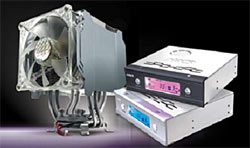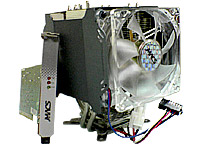Monsoon II Lite: Thermal Electric Cooling Tower
by Wesley Fink on February 6, 2007 6:00 AM EST- Posted in
- Cases/Cooling/PSUs
The heatpipe tower cooler is proving to be the most effective type of air cooler you can buy in today's market. This was clearly demonstrated in the AnandTech review of the Tuniq Tower and the recent review of two low-cost cooling towers. But like all air and water coolers, the heatpipe tower cannot cool lower than the ambient temperatures of the system. If your room is 21C, then that is the lowest possible temperature you can achieve with air or water cooling. Fortunately that is normally more than enough cooling for most overclocking, but some want to carry overclocking even further. To achieve sub-ambient temperatures, phase-change is often used, which can often cool processors to sub-zero temperatures. Phase-change is effective, but it is very expensive compared to air or water cooling and the phase-change system is extremely bulky - often much larger than the entire computer in the case.
Another sub-ambient cooling solution is TEC (Thermal Electric Cooling), which is also called Peltier cooling. For those who enjoy trivia Peltier cooling was named for the French discoverer Jean Charles Athanase Peltier. It is similar in concept to phase-change, but the TEC can in theory be much quieter and more compact, since the compressor used in phase-change cooling is not required. What is required with TEC is some means of heat dissipation. The Peltier cooler reaches sub-ambient temperatures on the cold plate, but the heat on the hot side has to be removed for the cooler to continue to work effectively. That is where efficient heat removal becomes important.

Vigor Gaming has produced cases and coolers that combine TEC and effective cooling. The Monsoon II was first introduced last year, and it represents the second generation of the Monsoon Cooler. It combines a two-phase TEC (on, half-on, off) with a fin tower and heatpipe cooler. The TEC/Cooler is controlled by a 5.25" bay mounted LCD controller that monitors and controls the processor temperature. The complete Monsoon II package has a street price of about $150.

The Lite version of the Monsoon II is being introduced this week. It uses the same TEC/Cooler as the more expensive Monsoon II, but substitutes a PCI card for the LED controller. The advantage is price, as the new Lite version will list for around $100, and the street price is expected to be in the $89 range. Lite does not mean performance is compromised in any way, as the TEC cooler is exactly the same as the more expensive Monsoon II.
The idea of a combining a TEC running at low power with an effective heatsink tower cooler is intriguing, to say the least. Vigor claims that their method of running lower power to the TEC and turning the element on, on half power, and off as dictated by temperature monitoring is much more effective than the more normal method of TEC cooling, which is always on. They also claim their monitoring method and intermittent operation virtually eliminates concerns about condensation on the cold plate side of the TEC.
These are interesting claims, but they are not easily explored in a cooler review. Instead we will concentrate on the most obvious question raised by this technology, and that is does it work as claimed? Does the Monsoon II Lite cool better than the top air towers like the Tuniq Tower 120? Is noise well controlled or are there penalties in using this cooling method? That's what we aim to find out.
Another sub-ambient cooling solution is TEC (Thermal Electric Cooling), which is also called Peltier cooling. For those who enjoy trivia Peltier cooling was named for the French discoverer Jean Charles Athanase Peltier. It is similar in concept to phase-change, but the TEC can in theory be much quieter and more compact, since the compressor used in phase-change cooling is not required. What is required with TEC is some means of heat dissipation. The Peltier cooler reaches sub-ambient temperatures on the cold plate, but the heat on the hot side has to be removed for the cooler to continue to work effectively. That is where efficient heat removal becomes important.

Vigor Gaming has produced cases and coolers that combine TEC and effective cooling. The Monsoon II was first introduced last year, and it represents the second generation of the Monsoon Cooler. It combines a two-phase TEC (on, half-on, off) with a fin tower and heatpipe cooler. The TEC/Cooler is controlled by a 5.25" bay mounted LCD controller that monitors and controls the processor temperature. The complete Monsoon II package has a street price of about $150.

The Lite version of the Monsoon II is being introduced this week. It uses the same TEC/Cooler as the more expensive Monsoon II, but substitutes a PCI card for the LED controller. The advantage is price, as the new Lite version will list for around $100, and the street price is expected to be in the $89 range. Lite does not mean performance is compromised in any way, as the TEC cooler is exactly the same as the more expensive Monsoon II.
The idea of a combining a TEC running at low power with an effective heatsink tower cooler is intriguing, to say the least. Vigor claims that their method of running lower power to the TEC and turning the element on, on half power, and off as dictated by temperature monitoring is much more effective than the more normal method of TEC cooling, which is always on. They also claim their monitoring method and intermittent operation virtually eliminates concerns about condensation on the cold plate side of the TEC.
These are interesting claims, but they are not easily explored in a cooler review. Instead we will concentrate on the most obvious question raised by this technology, and that is does it work as claimed? Does the Monsoon II Lite cool better than the top air towers like the Tuniq Tower 120? Is noise well controlled or are there penalties in using this cooling method? That's what we aim to find out.










19 Comments
View All Comments
hox - Friday, February 23, 2007 - link
Looking at your evaluation of this cooler, the screen shot you provide of the Nvidia monitoring software shows a Cpu temp of 49C and a system temp of 35C. Since you state you used this software to monitor temps during your evaluation could you please explain how the worst heat sink (intel stock cooler) started at 41C at idle. What heat sink was in place during your screen shot of the nvidia software? Also more information is needed to evaluate the product, in particular what is the fan arrangement in the mid tower case? Fan Number, CFM, size etc. The performance of each heatsink is highly dependent on the supplied flow of air, and there is considerable variability in how each heat sink works with the available flow. Knowing more about your standard set up would be helpful. Finally many users of the Qx6700 cpu have reported a higher initial tempearture value for this cpu. It would be nice to see in your evaluations an assessment of this processor as it typically runs 10 degrees C hotter than the dual core extremes.customcoms - Tuesday, February 6, 2007 - link
For more information, and real world tests by some of the top overclockers out there, check out this thread: http://www.diy-street.com/forum/showthread.php?t=6...">http://www.diy-street.com/forum/showthread.php?t=6...There are real world temperatures AND comparisons with other top cooling, including water. In essence, the results you see here are VERY typical. For instance, processors that would top out at 2.9ghz under HIGH END, CUSTOM WATERCOOLING (TDX block etc.) would then push on to hit 3ghz+ with the TEC. Personally, I'd rather spend the $90 on a the monsoon to reach higher clocks than $300+ watercooling setups, and not have to worry about leakage.
Avalon - Tuesday, February 6, 2007 - link
The Coolit Eliminator sells for about $200, and is similar to the Freezone. I'd definitely like to see a comparison of either. Good review.nickfd - Tuesday, February 6, 2007 - link
For my next rig, I want to use peltier/TEC, but I dont want a 2 pound block on my CPU. I want to use a 1/2" tube liquid loop with reservoir, radiator, and pump. Does anyone have, or can recommend a combination liquid/peltier block, or could point me in direction to look?Thanks much!
Wesley Fink - Tuesday, February 6, 2007 - link
The Coolit Freezone is a liquid/TEC combo. See comments above for more Freezone info.Tiamat - Tuesday, February 6, 2007 - link
Since the peltier "runs" at about 77 F, and it hits about 90 - 110 F in the summer depending on where you live, I wonder if condensation will become a problem for this circumstance.mpc7488 - Tuesday, February 6, 2007 - link
If it's 110 degrees in your house, I feel for you and suggest you sink the $89 towards Central A/C.In all honesty though, condensation is a concern, my brother smoked 2 machines when experimenting with Peltier cooling, water dripped from the heatsink down into the socket.
ViperV990 - Tuesday, February 6, 2007 - link
Shouldn't the target temperature on the cold side of the TEC be the case ambient temperature around the processor to avoid condensation altogether?cheetah2k - Tuesday, February 6, 2007 - link
I think that the comparison with the other coolers is very primitive. You should compare this to the likes of the Coolit Freezone or Eliminator as they too are TEC related coolers. I have the Freezone myself, and i enjoy the overclocking boost it gives my AMD FX-60 sitting stable at 3.15Ghz at 1.52vWesley Fink - Tuesday, February 6, 2007 - link
We wanted to get a wider variety of coolers in our database before tackling the Frezzone review. It should also be pointed out that the self contained six-TEC liquid cooled Freezone has a retail price of $400 and a street price of around $300. This is considerably more expensive than the $89 street price of the Monsoon II Lite. We have heard great things about the Freezone, and we do have one in the lab for testing. However, it is certainly in a different price category than the Monsoon II Lite, which is closer in price to heatpipe tower air coolers.